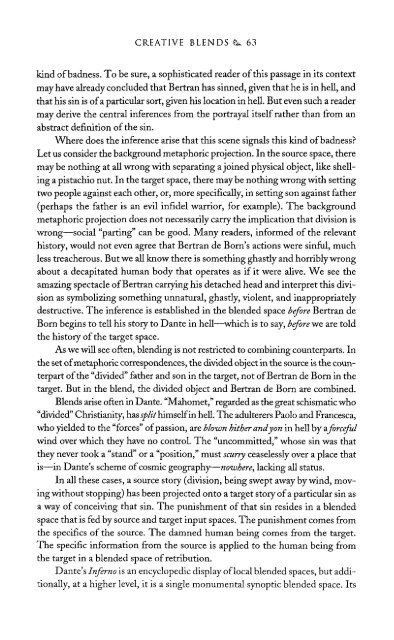The Literary Mind.pdf
The Literary Mind.pdf
The Literary Mind.pdf
Create successful ePaper yourself
Turn your PDF publications into a flip-book with our unique Google optimized e-Paper software.
CREATIVE BLENDS 63<br />
kind of badness. To be sure, a sophisticated reader of this passage in its context<br />
may have already concluded that Bertran has sinned, given that he is in hell, and<br />
that his sin is of a particular sort, given his location in hell. But even such a reader<br />
may derive the central inferences from the portrayal itself rather than from an<br />
abstract definition of the sin.<br />
Where does the inference arise that this scene signals this kind of badness?<br />
Let us consider the background metaphoric projection. In the source space, there<br />
may be nothing at all wrong with separating a joined physical object, like shelling<br />
a pistachio nut. In the target space, there may be nothing wrong with setting<br />
two people against each other, or, more specifically, in setting son against father<br />
(perhaps the father is an evil infidel warrior, for example). <strong>The</strong> background<br />
metaphoric projection does not necessarily carry the implication that division is<br />
wrong—social "parting" can be good. Many readers, informed of the relevant<br />
history, would not even agree that Bertran de Born's actions were sinful, much<br />
less treacherous. But we all know there is something ghastly and horribly wrong<br />
about a decapitated human body that operates as if it were alive. We see the<br />
amazing spectacle of Bertran carrying his detached head and interpret this division<br />
as symbolizing something unnatural, ghastly, violent, and inappropriately<br />
destructive. <strong>The</strong> inference is established in the blended space before Bertran de<br />
Born begins to tell his story to Dante in hell—which is to say, before we are told<br />
the history of the target space.<br />
As we will see often, blending is not restricted to combining counterparts. In<br />
the set of metaphoric correspondences, the divided object in the source is the counterpart<br />
of the "divided" father and son in the target, not of Bertran de Born in the<br />
target. But in the blend, the divided object and Bertran de Born are combined.<br />
Blends arise often in Dante. "Mahomet," regarded as the great schismatic who<br />
"divided" Christianity, has split himself in hell. <strong>The</strong> adulterers Paolo and Francesca,<br />
who yielded to the "forces" of passion, are blown hither and yon in hell by a forceful<br />
wind over which they have no control. <strong>The</strong> "uncommitted," whose sin was that<br />
they never took a "stand" or a "position," must scurry ceaselessly over a place that<br />
is—in Dante's scheme of cosmic geography—nowhere, lacking all status.<br />
In all these cases, a source story (division, being swept away by wind, moving<br />
without stopping) has been projected onto a target story of a particular sin as<br />
a way of conceiving that sin. <strong>The</strong> punishment of that sin resides in a blended<br />
space that is fed by source and target input spaces. <strong>The</strong> punishment comes from<br />
the specifics of the source. <strong>The</strong> damned human being comes from the target.<br />
<strong>The</strong> specific information from the source is applied to the human being from<br />
the target in a blended space of retribution.<br />
Dante's Inferno is an encyclopedic display of local blended spaces, but additionally,<br />
at a higher level, it is a single monumental synoptic blended space. Its















